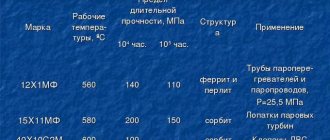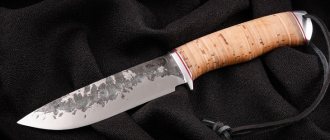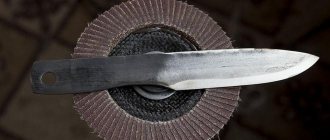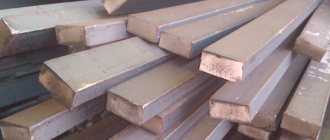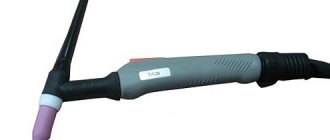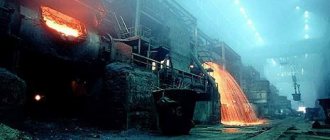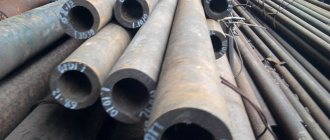For more than 3,000 years, humanity has been processing iron, making various tools, machines, and household utensils. Despite the relatively high mechanical properties of this metal, its destruction due to corrosion does not contribute to the long-term use of iron products in the open air.
Another significant limitation in the use of this metal is its low aesthetic qualities. To significantly improve these properties in the production of steel, additives are used that impart resistance to oxidation, the appearance of shine on its surface and a significant increase in the strength of the metal.
Description of the term - what is alloy steel
Physical properties, such as strength, ductility, fragility, can be increased or decreased several times. Changing the crystal lattice of materials is actively used in metallurgy, as well as in the production of numerous parts and housings for automotive, machine, machine tool and other production, as well as for the creation of building structures and tools. The scope of application is so wide that the alloy began to be produced in large quantities; it is gradually replacing the share of manufactured iron and ordinary steel substances.
Based on the information provided, steel alloying is a metallurgical smelting process during which impurity materials are added to the composition. There are two types of operations:
- Volumetric – when the components fall into the deep structure. Chromium, nickel, etc. are introduced into the melt or charge.
- Surface - during it, diffusion or other spraying occurs, that is, only the top layer is covered.
The process has come into use relatively recently. Experiments began for the first time in 1882. And from the very first sample, the researchers discovered that along with the improvement in physical properties, the degree of machinability was significantly reduced. In simple words, the material simply became difficult to work with. Of course, by now all the additional effects of alloying have been studied, so special GOST standards have been drawn up for different metalworking methods.
Chemical composition of alloy steel
There are constant components - these are those that are present in any alloy of this category; there are also optional alloying ingredients. First, we list those that form the classic material:
- Iron. It is a very malleable metal in itself, which is mined from ore. The peculiarity is that there is quite a lot of it in the bowels of the earth; in terms of extraction it is in second place after aluminum. It reacts well, which is why it can be fused in various ways. In percentage terms, it can be from 45 to 97-99 percent. We will not name the exact number of parts, since there are many grades of steel, the composition of which varies.
- Carbon. This is one of the integral components. The combination of these substances increases the natural qualities of iron. On average, it is added from 0.1% to 1.4% to the total mass. The higher its content, the higher the strength. All steel products are divided into carbon and low-carbon.
- Manganese. An interesting ingredient that is also an alloying ingredient. Although if it is less than 1%, then it does not impart any special properties. In itself, it is a very beautiful silvery metal; it is from this that the ingots acquire their characteristic iridescence. But the main merit of manganese is that it is a deoxidizer, that is, it helps remove oxygen from the alloy, which, in turn, negatively affects the properties. There are interesting compounds (named after Hadfield - the creator) that contain about 11 - 14 percent. In this case, the steel loses its magnetic qualities, and also becomes very impact-resistant and wear-resistant, since it is strengthened upon impact.
- Silicon is an essential element, which, with a high content (more than 0.8%), has alloying properties. It is also a deoxidizer, and also increases durability, elastic limit, heat resistance and some other features.
In addition, the composition usually contains harmful and hidden impurities. They are trying to get rid of them, but, unfortunately, they cannot be completely removed. Therefore, in extremely small doses the samples contain:
- Sulfur, which increases red brittleness - cracks appear on the heated workpiece.
- Phosphorus, it leads to an increase in cold brittleness, that is, fragility.
- Oxygen, nitrogen and hydrogen “loose” the structure.
- Oxides and nitrides can lead to tears.
The third group of components are random. They end up in the container along with the charge, that is, with a mixture of starting materials, and do not have a positive effect. They can be harmless or not very useful, but due to the small proportion of content they are practically unimportant. These include:
- copper;
- zinc;
- lead;
- chromium;
- nickel, etc.
And finally, the fourth group is special alloying additives. These elements are additionally introduced to enhance certain characteristics. They are the ones who make the classic alloy hardened. We will list the components in more detail in the corresponding section of the article.
Types and grades of high-alloy steel
| Steel category | Key Features | Brands of the corresponding category |
| Martensitic grades | They contain carbon in decent quantities (up to 0.7%), the chromium content is average (from 8 to 19%), and they contain silicon and/or manganese in small quantities. | 07Х16Н4Б, 13Х11Н2В2МФ, 30Х13 |
| Ferritic grades | Low carbon content (up to 0.15%), high to medium chromium content (12 to 30%), may contain silicon, titanium and/or manganese in very small quantities | 12Х17, 08Х13, 15Х25Т |
| Austenitic grades | Low carbon content (up to 0.2%), moderate to medium chromium content (from 10 to 18%), nickel in various concentrations (from 3 to 25%), manganese in various concentrations (from 1 to 14%), in small quantities may contain silicon, nitrogen | 20X25N20S2, 12X25N16G7AR |
| Composite martensitic-ferritic grades | Low carbon content (up to 0.2%), high or medium chromium content (from 10 to 16%), in small quantities - vanadium, manganese, silicon | 12Х13, 15Х12ВНМФ |
| Composite austenitic-ferritic grades | Low carbon content (no more than 0.18%), high chromium content (average 23%), manganese in various concentrations (there are alloys with both a low content of 0.5% and a high content of 9%), small inclusions are possible silicon, aluminum, titanium | 15Х18Н12С4ТУ, 12Х21Н5Т |
| Composite austenitic-martensitic grades | Carbon in various concentrations (from 0.1 to 1%), high chromium content (on average about 16%), in small concentrations - aluminum, silicon, titanium | 08Х17Н6Т, 09Х15Н8У1 |
Types of alloy steels
The main classification divides all brands into three subtypes according to the amount of useful impurities. Let's present the percentage in the table:
| Name | Additive percentage |
| Low alloy | About 2.5%. Positive qualities have increased, but malleability and other characteristics for metalworking have not changed much. |
| Medium alloyed | From 2.5% to 10%. This connection is used most often. |
| High alloy | From 10% to 50%. Maximum strength and high cost are the distinctive features of such products. |
In addition, all common alloy steels differ by grade. We will talk about this in more detail in the section on labeling.
Classification
Regardless of the percentage of alloying substances in the alloy, it can also be divided into three subtypes:
- Structural – used for the manufacture of various parts, mechanisms and structures in mechanical engineering, machine tool building, other areas of industry and construction. This is a very durable material that can withstand large static and dynamic loads. It is from these brands that engines and spare parts for cars are made.
- Tool - very heat-resistant, which is intended for creating tools - both manual and machine tools. Most milling cutters, cutters, and drills are made of this kind of steel.
- With special properties. If the previous two varieties were more likely to be considered for their strength and reliability, then this subspecies is characterized by chemical or thermal resistance.
A number of researchers even classify the last category separately, arguing that it can be divided into:
- Heat resistant - they can withstand temperatures up to 1000 degrees.
- They are resistant to metal corrosion, so they can be used in products and structures that are intended for use in conditions of high humidity.
- Heat-resistant and scale-resistant - characteristics indicate their immunity to decay.
Key Features
High-alloy steel, in addition to carbon and iron, contains a large amount of alloying additives (from 10 to 50%). As additional components: chromium, nickel, silicon, manganese, tungsten, molybdenum, vanadium, aluminum, cobalt, titanium, as well as various rare earth metals.
Most often, chromium and nickel act as additional components - the remaining components are usually contained in small quantities. Although there are some exceptions: a simple example - austenitic grades of high-alloy steels can contain manganese in a concentration of 1 to 15%.
The reasons for adding alloying additives are very simple - they change the structure and physical properties of the steel alloy, which allows a person to obtain a metal with the desired properties.
Categories
Categories of high-alloy steels depending on their physical properties:
- Scale-resistant (heat-resistant) high-alloy steels. The main feature of such alloys is complete resistance to moderate to high temperatures (up to 550 degrees Celsius) of the environment in an unloaded state. In other words, such steels can withstand overheating well for a long time if they do not need to support any heavy weight. Please note that in addition to high temperatures, scale-resistant steels also tolerate long-term exposure to moderately toxic chemicals.
- Heat-resistant high-alloy steels. Based on the name, you might think that heat-resistant and heat-resistant alloys are the same thing, but this is not entirely true. Heat-resistant alloys can withstand high temperatures (up to 800 degrees and above) under high load conditions, but for a short time. In other words, such alloys can withstand high heat for a short period of time (whereas heat-resistant alloys can withstand moderate heat for a long time). Short-term stability also applies to highly toxic chemicals.
- Anti-corrosion (stainless) steel alloys. They are fully resistant to all main types of corrosion (surface, crystalline, electrochemical, and so on). Please note that in the composition of such alloys, the alloying components are evenly distributed throughout the steel alloy, which makes the material evenly resistant to all anti-corrosion influences. Why is this so important? A simple example: when chrome plating, only an external anti-corrosion coating is formed, which can be damaged or erased for natural reasons - high-alloy alloys contain anti-corrosion additives throughout the metal, which makes such alloys more stable.
Application
High-alloy steels have found wide application in everyday life. They are used to make various parts - for cars (trucks, cars, electric cars, etc.), ships, planes, tanks. Also, high-alloy steels are very often used in construction to create load-bearing beam-type structures.
Alloying components in this case can play many roles - they make the material more heat-resistant, they improve its anti-corrosion properties, and so on. High-alloy steel is also used to make dishes, medical instruments, household utensils, and so on.
What do alloy steel additives mean and their effect on properties
We have already mentioned that some components can be either mandatory or special impurities, depending on their quantity. Different brands may contain:
| Element | Influence |
| Chromium | Significantly protects against corrosion, improves hardness and impact resistance. It is significant that a lot of chromium is added to stainless steel. |
| Nickel | With the addition of this substance, the alloy becomes more viscous and ductile, its fragility decreases, which is very important, for example, before pressure treatment - pressing or stamping. |
| Titanium | Reduces graininess, makes the structure more uniform, and therefore less susceptible to cracks and splits. Additionally, susceptibility to metalworking and rust resistance are improved. |
| Vanadium | As with the introduction of titanium, a less granular shape can be seen. An increase in fluidity and tensile strength is also characteristic. |
| Molybdenum | After it, the hardening process is much more effective, and fragility is reduced, and greater resistance to rust appears. |
| Tungsten | In addition to increasing hardness, it also helps with heat treatment - the grain size does not increase when heated, and during tempering the fragility does not suffer much. |
| Silicon | Its task is to simultaneously increase strength and maintain viscosity levels. But if it is more than 15%, then you can observe an increase in magnetic permeability and resistance to electricity. however, you need to be careful as the steel becomes more brittle. |
| Cobalt | Well protects against rapid destruction under the influence of high temperatures; increases impact resistance |
| Aluminum | Adds scale resistance, that is, in high heat, rapid oxidation does not occur. |
We have listed the main additives that are used during alloying. We will also make a separate table for impurities that cannot be completely removed from the composition.
| Element | Influence |
| Carbon | Greatly increases strength, hardness, impact resistance, and yield strength. But there are strict restrictions on adding it. Simply put, if it is more than 1.2 - 1.4 percent, then all of the listed characteristics, on the contrary, will decline along with plasticity. |
| Manganese | Above we presented its importance as a deoxidizer. But the substance protects not only from oxygen, but also from sulfur, and why protect, read below. |
| Sulfur | Its content exceeds 0.6% is called high. An impurity in such a concentration leads to poor weldability, reduced strength, ductility and corrosion resistance. in general, this ingredient does not bring any benefit, only harm. |
| Phosphorus | Its presence can lead to an increased rate of fragility and fluidity, as well as a decrease in viscosity and ductility. |
| Nitrogen, hydrogen and oxygen | Gases contribute to loosening of the structure, due to which the alloy becomes brittle, less resistant to stress and insufficiently viscous. |
Marking: what grades of steel are called alloyed
The regulatory document that regulates the name of each new subspecies is GOST 4543-71. The need for such systematization arose due to the huge number of varieties, which are only increasing every year, because new connections and proportions are discovered. Each type is intended for a separate field of activity and is unique in its own way. To distinguish them, special applications are used. Here's what it looks like:
Or like this, in English:
In the first case, no letters were indicated, which means it is just a classic alloy with additives. But in the second we see an “X” in front - its presence indicates that this is chrome steel. If there were others at the beginning, they would testify to the following:
- F – stainless steel;
- E – magnetic;
- I am chromium-nickel stainless steel;
- Ш – ball bearing;
- R – high-speed tool.
Abbreviations can also appear on the right. For example:
- A – high quality;
- Ш – especially high quality;
- H – obtained by cold-working method;
- TO – heat-treated rolled steel was used.
Now about the numbers and letters inside the marking itself. The numerical designation usually shows the percentage of the substance. But since it is not possible to clarify everything to hundredths, it is customary to round to whole parts. And if the content does not exceed 1%, then the letter symbol is present, but the number is not placed. The elements themselves are written either by chemical formulas or by first values. Let's look at a more complete list:
If you want comprehensive lists and lists of brands, you should look at the above-mentioned GOST.
Low alloy structural steel
Low-alloy steel has found its application in the production of cars, rolling stock, locomotives, and in equipment for agricultural and industrial purposes. Any products made from low-alloy steel can withstand very large and heavy loads. They don't have any restrictions.
For alloy steel, the markings can be as follows: two numbers (carbon content), letters without numbers (alloying element), a letter and a number (alloying element as a percentage) and a letter at the end of the marking (an indicator of very high quality steel).
Application of alloy steel
There are so many areas of use that it is difficult to list them. Let's just talk about some of the industries:
- Medical instruments, including sharp cutting objects.
- Blades.
- Bearings and other parts with high radial and support loads.
- Cutters, milling cutters, drills and other equipment for metalworking machines.
- Housings for equipment and devices.
- Stainless steel utensils - buckets, basins, etc.
- Made for the automotive industry.
This and much more can be made from this substance. Any task that requires superior strength properties can count on alloy steel.
Properties
Depending on the alloying components, they may vary, but in general the following characteristics are improved:
- Corrosion resistance. Sometimes it is enough just to treat the top layer with a protective compound, but what about parts that are constantly in contact with moisture and oxygen? The answer is simple - dope.
- Strength.
- Hardness.
- No fragility.
- Resistant to tensile and compressive loads.
- The desired level of viscosity and yield strength.
- Reducing magnetization.
Production
The main method is metallurgical. During this process, the required amount of impurities is added to the molten metal. Then additional conditions are set in which diffusion or other reactions occur at a higher rate.
The second option for doping is applying a surface layer in such a way that the substances begin to penetrate each other.
Welding alloys
We noted that after adding components, metalworking, including using a welding machine, becomes more difficult. Let's see what the features are.
Low alloy
Recommendations:
- The seam must not be allowed to cool quickly - then microcracks may appear.
- The device must be with reverse polarity and constant voltage.
- Calcium fluoride coated electrodes must be used.
- The process is without interruption, smoothly at an average speed of 20 m/h.
- Voltage – 40 V and current – 80 A.
Medium alloyed
Peculiarities:
- The electrodes should contain less alloying substances than the alloy.
- If the sheet is wider than 5 mm, use argon welding.
- For a gas appliance, use a mixture of acetylene and oxygen.
Welding of high alloy steels
Welding high-alloy steels differs from welding conventional steels. The thing is that most high-alloy alloys have increased thermal conductivity and increased linear expansion of the metal, which forces a number of important changes to be made to the welding procedure:
- Increased thermal conductivity leads to excess heat collecting on the surface of the metal, which makes it much easier to melt the steel deeper. Therefore, when welding, it is necessary to reduce the welding current by 15-25% to avoid damage to the part.
- Due to the increased coefficient of expansion of the metal when heated, more severe deformation of the metal also occurs. When working with voluminous rigid volumetric structures, the risk of cracks also increases. Therefore, extreme care must be taken when welding.
Adviсe
In addition to this, there are many other features of welding high-alloy steels. When working with alloys that do not contain titanium or niobium, you need to remember the heating temperature of the welding arc. When the metal is heated to temperatures above 500 degrees, such alloys lose their anti-corrosion properties.
If, during welding, for some reason you brought the metal fragment to a temperature above 500 degrees, then in this case it is necessary to perform hardening or heat the fragment to a temperature of 850 degrees. In this case, alloying clusters dissolve and are evenly distributed throughout the alloy.
Due to the presence of alloying additives, the risk of steel cracking during welding increases significantly. To avoid this, you need to use electrodes coated with molybdenum, manganese or tungsten. When such tools are used, the seam area acquires a fine-grained structure, which prevents the formation of cracks.
Preheating the steel to a temperature of 100-300 degrees Celsius also reduces the risk of weld cracking. In this case, the heat will be evenly distributed throughout the entire thickness of the metal and prevent the formation of cracks.
Steel alloys with a carbon content of less than 0.12% must be heated before welding. If this is not done, then with a high degree of probability, after welding, cracks and corrosion build-ups will form at the weld site.

